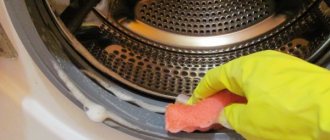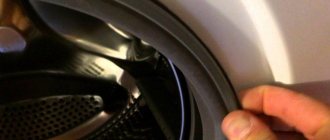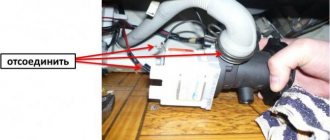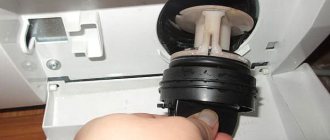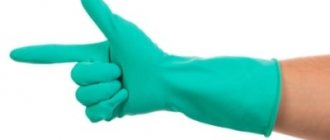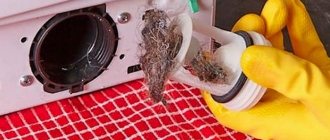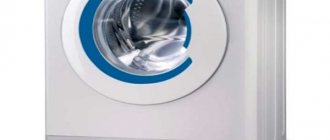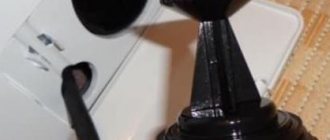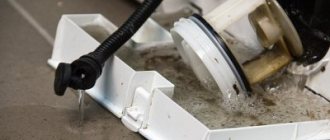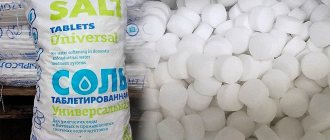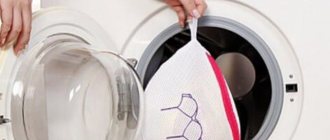The doors of front-loading washing machines are equipped with rubber bands. The part serves as a reliable seal and seals the drum, which is filled with water during washing.
Like all other parts of the automatic machine, the rubber seal requires periodic maintenance. You will learn how to properly treat the protective cuff and extend its service life here.
Why do you need to clean?
The rubber seal has a complex design with bends and folds. Dirt, hair, lint and debris accumulate in large quantities in the folds of the cuff - everything that was not removed through the filter and drain hose.
Due to the configuration, the rubber constantly maintains high humidity , which serves as an excellent environment for mold.
Attention! The remains of garbage are subject to rotting and mold infection, unpleasant odors and black spots appear - colonies of fungi and bacteria.
The musty smell not only creates an unfavorable atmosphere in the room, but also permeates washed clothes. Therefore, a responsible housewife should not have any questions about why the rubber band needs to be cleaned.
Causes of unpleasant odor and fungus
The unpleasant odor of the seal appears for the same reasons as in the drum of the unit:
- Incorrect installation of the device - if the machine is placed on the floor at an angle, the water does not completely drain out of the pipes.
- Abuse of low-temperature washing mode - the insides of the machine cannot be disinfected with hot water.
- Inadequate care of parts and detergent container.
- Refusal to use anti-scale agents and powders with bleaching properties.
- If the device door is constantly closed, the drum and rubber band do not have time to dry out, but remain wet.
- Storing dirty laundry in a “washing machine”, where bacteria multiply intensively and a stench appears.
- Lack of preventive cleaning of the washing machine - inside and outside the body.
- Incorrect use of rinse aid - it must be washed off with a double rinse, otherwise an oily residue remains, ideal for fungus.
Important! Poor water quality is one of the causes of odor and mold. It is recommended to use water softeners that will fight limescale on the gum.
Find out now how to get rid of mold in your washing machine.
How to clean a car under the rubber
It is no secret that the rubber band can be removed completely and the surface underneath can be thoroughly washed. The scheme is simple:
- It is necessary to use a screwdriver to pick up the clamp on which the rubber cuff is attached
- You need to remove the clamp, carefully use a screwdriver in a circle
- Next, you can remove the rubber cuff
- Wash off any visible dirt from the gum with water.
- Soak the seal in a chlorine-containing substance
- Dry the part and put it back.
If you have difficulty removing the rubber band, but need to clean it, you can call an equipment maintenance specialist.
Complete washing machine cleaning procedure
You can completely clean your washing machine using citric acid.
- You will need several packs of citric acid (which depends on the loading volume of the machine)
- Pour the acid into the washing powder compartment.
- Run the machine at maximum speed for a long wash.
The acid will clean the machine of scale and also get rid of foreign odors.
Choice of product
A variety of household chemicals are suitable for caring for the sealing cuff of an automatic machine. It is important that they not only have bleaching, deodorizing and cleaning properties, but also be able to cope with mold and bacteria.
Is there mold in your washing machine?
Not really
Baking soda
Use soda to clean the cuff manually - a self-prepared gruel or soap solution will do. In the first case, 2-3 tablespoons of soda are combined with a small amount of water to obtain a paste.
Apply the product to a kitchen sponge and wipe the gum around the entire perimeter, carefully treating the inner surface.
The second option is to mix a spoonful of baking soda with gel or dishwashing liquid . A soap solution works in the same way - apply to dirt and scrub thoroughly. You need to let the soda act for a while (about half an hour), and then rinse off the remaining substance with clean water.
Important! During the washing process, it is forbidden to stretch the elastic band too much, otherwise the seal of the automatic machine will be broken.
Antibacterial and chlorine-containing agents
This group of products includes household chemicals containing disinfectant additives to eliminate bacteria, viruses and mold. They do not have to be designed specifically for the washing machine.
Universal products for caring for plumbing fixtures, tiles, and work surfaces in the kitchen are suitable:
- “Toilet duckling”;
- “Domestos”;
- Sanfor;
- Neomid;
- Cillit Bang;
- Mildew remover;
- Veksa;
- Vanish.
Advice! Choose the release form that is convenient for you - spray, gel or liquid. The drug is applied to the gum with a washcloth or a damp cloth, and after 30-60 minutes it is washed off along with the dirt.
Copper sulfate
Copper sulfate pentahydrate is especially popular among summer residents for controlling pests of trees and shrubs. In everyday life, the antiseptic, antifungal and disinfectant properties of the liquid are also useful.
How to wash properly:
- Prepare a cleaning solution - 30 g of substance per 1 liter of clean water.
- Soak a rag or washcloth in the liquid and treat the cuff without missing a centimeter.
- Leave the drug to “work” for about a day.
- After a day, turn the machine on to the quick wash mode.
- At the end of the process, wipe the gum dry and leave the door open so that the surfaces are completely dry.
How to remove dirt from a rubber seal at home
To wash the area between the rubber band of the machine and the drum, you need to move it aside, then walk the sponge over the dirty area. It is recommended to wear gloves during the procedure.
Chlorine-based household chemicals will help get rid of stains. Most often, Tiret, Utenok, and Domestos are used for washing machines, but you can use others.
After processing, the machine door must be closed and left for 30 minutes. This will allow the product to better act on the dirt under the rubber band. After half an hour, wash the surface of the cuff with plain water and wipe with a dry cloth.
How to remove stains under an elastic band:
- Use a screwdriver to unhook the clamp that supports the seal.
- Remove the clamp with the same screwdriver.
- Wet the contaminated area of the cuff with water.
- Leave the cuff to soak in the chosen product.
- Wait until the rubber is dry and then attach it to the washing machine.
This way you can clean the hard-to-reach area between the cuff and the drum.
After washing thoroughly, the gum should be dried.
Rules for cleaning the sealing part
Mold is not the only problem that housewives face when caring for the unit. The washing machine may show signs of rust, limescale , dirty spots and an unpleasant odor. We will now tell you how to deal with each of the problems.
How to remove dirt and stains?
Debris and dirt most often accumulate in the internal space - it is necessary to unscrew the cuff and remove all foreign objects. It is most convenient to do this with a gloved hand and a small washcloth or rag, which can easily penetrate into a narrow space.
Then apply any of the chlorine-containing products (“Domestos”, “Utenok”, etc.) to the same washcloth and treat all parts of the rim. Then close the door of the unit so that the drug works better. After half an hour, complete the procedure by washing with clean water and wiping dry.
Soda gruel also works well with dirt stains - a soft abrasive helps to scrub away stubborn dirt without the risk of damaging the surface.
Important! In advanced cases, you will have to dismantle (remove) the cuff in order to thoroughly disinfect and remove dirt.
From plaque and rust
Not only plumbing fixtures and faucets suffer from limescale deposits, but also washing machines. You can fight plaque with citric acid - place 2 tablespoons directly into the drum and wash on the longest cycle.
Acid removes deposits not only from the seal, but also from the drum with the heating element.
Anti-lime tablets for dishwashers are also suitable for caring for washing machines . It is enough to place 5-6 tablets in the drum and “scroll” the unit idle at high temperature.
Rust does not form on the rubber itself, but along its perimeter on the metal body of the device. But it is also necessary to fight it, otherwise more extensive cracks and stains will appear.
Acetone or nail polish remover will come to the rescue:
- Use a damp cloth to remove visible dirt and rust particles.
- Apply acetone to a cotton pad or a piece of dry cloth and spot treat problem areas.
- Leave the solution on the surface for approximately an hour.
- Turn on the single rinse mode at a temperature of at least 60 °C.
- After rinsing, wipe the rubber seal dry and leave the device to ventilate.
From an unpleasant odor
Housewives manage to eliminate unwanted aromas and eliminate the cause of their appearance with the help of ordinary “Whiteness”.
Instructions for use:
- Pour 1 liter of bleach into the container under the powder.
- Turn on the machine, having previously selected high temperature mode and double rinse.
- Half an hour after the start of washing, the machine is paused for 2-3 hours.
- The unit is started again, and at the moment the rinsing begins, 2 cups of 9% vinegar are poured into the powder tray.
- When the machine finishes washing, wipe the cuff dry and leave the door open.
Substances with intense aroma and disinfectant properties will help get rid of the smell. The rubber band can be wiped:
- natural lemon juice;
- eucalyptus essential oil;
- rosemary, pine or basil oil.
Advice! Another effective option is to pour a couple of tablespoons of lemon juice into the container under the detergents and start the rinse mode at a temperature of 40 degrees.
If it turns black
Method No. 1. Regular table vinegar will help fight mold and at the same time clean the washing machine parts from plaque and dirt.
How to clean:
- Dilute vinegar with water in proportions of one to one.
- Pour the resulting solution inside the cuff - a couple of measuring cups are enough.
- Select the longest wash cycle at high temperature.
- 10 minutes after the start of washing, pause the unit, and after 2 hours start it again.
- Continue working and finally wipe all the insides with a dry cloth.
Important! This method can be used no more than once every 6 months, since the acid can destroy the rubber parts of the device.
Method No. 2. In case of extensive mold damage to the gum, you will need a solution of peroxide and vinegar. Take pharmacy peroxide with a concentration of 3%, vinegar - table vinegar, 9%.
Instructions:
- Mix vinegar and peroxide in equal proportions and place in a spray bottle.
- Wipe the dirt on the cuff with a damp cloth.
- Spray the solution over the entire rubber band, stopping at the most problematic areas.
- After 10 minutes, go through the dirt again with a washcloth or rag.
- Wash off dirt and remaining solution with a rag soaked in clean water.
Method No. 3. Monarda extract has antibacterial and fungicidal properties - this liquid dietary supplement can be purchased at the pharmacy.
To clean the gum, combine 15 ml of extract with 200 ml of cool distilled water. The solution is poured into a spray bottle and sprayed onto the sealing ring. The product does not require rinsing with clean water.
This is interesting: how to descale a washing machine, read here.
Rules for cleaning the seal
The cuff should be cleaned regularly. Otherwise, dirt will begin to get on your clothes, and an unpleasant odor will appear in the room.
Before carrying out manipulations, disconnect the washing machine from the electrical network.
Children and pets should not be in the room during cleaning.
If you use strong-smelling substances, open the bathroom door and open the windows.
Wear protective gloves and closed clothing to prevent harsh chemicals from coming into contact with your skin. If cleaning products come into contact with your eyes or skin, immediately wash the affected area with plenty of warm water.
Mold Prevention
What you need to do to prevent mold from appearing:
- Do not leave the machine door closed in standby mode;
- wipe the cuff dry after each wash cycle;
- do not overuse rinse aids;
- carry out periodic preventative washing “idle” with citric acid and bleaching powders;
- use softeners for hard water;
- wash at high temperature at least once a month;
- remove blockages in a timely manner and remove debris accumulating in the cuff;
- check pockets of clothes before putting them into the drum.
You should not forget about cleaning the rubber seal - this is one of the most problematic areas of the washing machine.
A dirty cuff serves as a source of bacteria and fungus, which negatively affect the hygiene of the home and the health of its inhabitants.
Use of household chemicals
Manufacturers are constantly expanding their line of products aimed at combating mold in the rubber bands of washing machines, but housewives assure that Domestos copes with the problem perfectly. Apply the solution to the surface of the gum, then wipe it well with a sponge. If you cannot wash all the folds, remove the cuff.
“Whiteness” can also wash the gum if you follow our instructions:
- Remove as much dirt as possible with a damp cloth.
- Dampen the sponge with the product and wipe the inside of the cuff.
- Wipe the washing machine drum.
- Close the door, wait half an hour.
- Turn on the washer in rinse mode.
It is possible that in advanced cases you will have to repeat the procedure, but more often “Belizna” copes with mold on an elastic band in one go.
